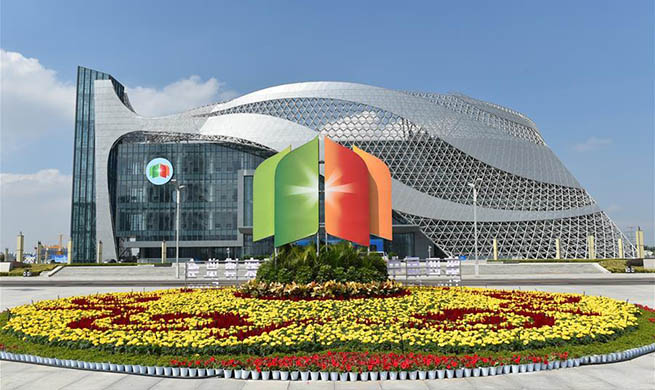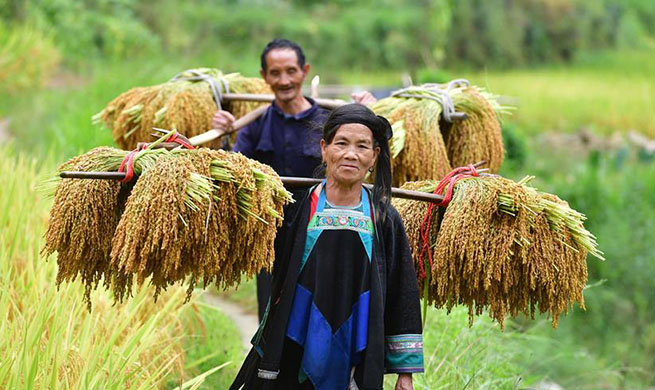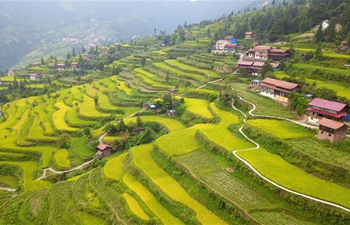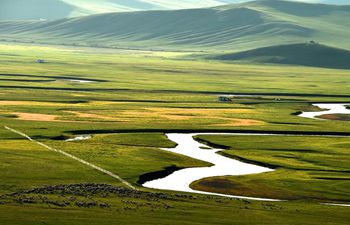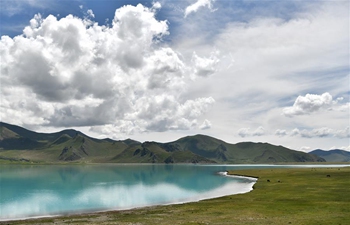XI'AN, Sept. 5 (Xinhua) -- Loess Plateau, with its endless highlands of yellow earth from land erosion on the banks of Yellow River, has been changing colors with local people's tireless afforestation efforts.
From a bird's-eye view over the city of Yan'an, northwest China's Shaanxi Province, the verdant rolling hills are hardly reminiscent of the strong winds and barren loesses depicted in local folk songs.
The plateau has been coated with green.
"The greening has already changed the microclimate, adding humid air and bringing a vitality to the place," said Yang Shuwei, head of Fengzhuang Township in the city.
Yan'an has returned more than 700,000 hectares of farmland to greening plants on steep slopes. The unremitting efforts of reforestation has enlarged the city's vegetation coverage rate to 81.3 percent last year from 46 percent in 2000.
Since 1999, a total of 1.25 million Yan'an locals from 286,000 rural households have participated in the "green revolution" that has created this miracle.
Pale yellow used to be the dominant hue of Yan'an, known as China's revolutionary base.
Barren hills stretched everywhere, and dust and sand blotted the sky when the wind blew, recalled Yan Zhixiong, former secretary of Nangou Village Committee of the Communist Party of China (CPC) in Yan'an.
"The mountains couldn't withstand the wind, nor could the soil hold water," he said.
The plateau is one of the regions suffering from the most severe land erosion on earth. The annual sediment into the section of Yellow River through Yan'an was as much as 258 million tonnes in the late 1990s, accounting for one sixth of the river's total.
Today, the amount has been reduced to 31 million tonnes, a sharp drop of 88 percent, according to the municipal bureau of forestry and grassland.
Meteorological data show that air quality in Yan'an has been improving year by year, with days of excellent or good air quality rising to 315 in 2018 from 238 in 2001.
Yan operates a travel company in Nangou Village and runs a guest house in the traditional cave house-style.
The resort brought in more than 1 million yuan (about 140,000 U.S. dollars) to the small village in a gully of the loess hills after six months of operation. Villagers have shared the benefits of the booming catering and tourist business.
The Chinese government has carried out a series of large ecological construction projects nationwide since 1999. Twenty years on, Yan'an people have kept planting trees under the harsh climate.
The effects of government-sponsored programs have given locals the chance to see lucid waters, lush mountains and fatter wallets. They have seen the success of this sustainable way of life, compared to the traditional farming on terraces for meager harvests.
The harvests now make the loesses more colorful. Red is the color of cash trees in Yan'an, with more than 160,000 hectares of pepper, date and other fruit trees. The city's apple tree planting area exceeds 250,000 hectares, generating an annual output value of more than 1 billion yuan.
Liu Gaoming, a local apple grower from Ansai District of Yan'an, has received many orders for his autumn harvest. He runs a 1.5-hectare orchard, which is expected to bring him a net profit of some 50,000 yuan a year.
"When the apples turn red, it is the most beautiful time in the fruit forest on the hillside," said Liu as he prepared for harvesting.











